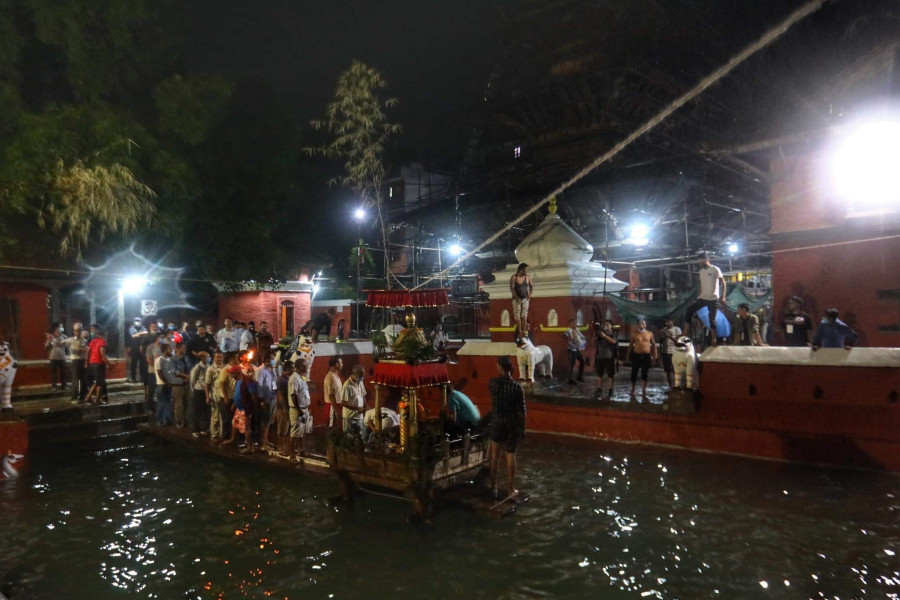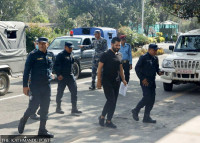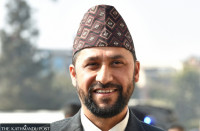National
Festival season could be a time for virus spread as elsewhere in the world, experts warn
Health Ministry to bring out do’s and don’t during festive season within days as people thronged to religious sites on Monday.
Anup Ojha
When Sarita Timalsena reached the Mahadevsthan temple early on Monday morning, she was expecting a few people to be around, given the concerns over the Covid-19 pandemic.
“And I had reached quite early, hoping to avoid the crowd,” said Timalsena, 31, who lives in Koteshwor, near the temple. “The crowd made me dizzy, so I decided to return home.”
Like many other Hindus, Timalsena too had been to the temple to perform puja and get the “raksha bandhan” on her wrist, a ritual that is observed as part of Janai Purnima festival celebrated on the full moon day of the Nepali month of Shrawan.
“It looks like people have forgotten how pervasive Covid-19 has become,” said Timalsena, a housewife.
So crowded was the place on Monday morning that even police had to intervene to disperse the people.
Ever since the lockdown has been lifted, Kathmandu has returned to the pre-Covid-19 days. Public buses are operating, restaurants are open and people are moving around freely–most of them without following the prescribed safety protocols.
And festivals attract even bigger crowds.
“If you look around the world, most of the Covid-19 cases are transmitted at religious centres and political gatherings,” said Dr Prabhat Adhikari, an expert on infectious disease and critical care.
With Janai Purnima on Monday, it’s the season of Hindu festivals in Nepal, and experts have warned that this could be a time for the spread of the infection among the people.
Janai Purnima is followed by Gaijatra on Tuesday after which other festivals like Teej, Indra Jatra and Dashain and Tihar, the biggest festivals of Nepalis, are observed.
It’s a catch-22 situation, said Padma Sagar Kakshapati, 58, of Dallu, who is all set to observe the Gai Jatra festival on Tuesday.
The Newars of Kathmandu Valley commemorate those who have passed away in the past year on Gaijatra.
Despite the pandemic, people’s sentiments are strong when it comes to religious festivals. Kakshapati admits that there is risk of the virus spreading, but he argues that people’s faith usually prevails over everything else.
“It’s about faith, so I think people will undertake the route for their deceased family members despite the growing risks of the virus spreading,” Kakshapati told the Post. “But definitely the jatra will be observed in an abridged way. And they will try to maintain physical distance.”
After two Covid-19 cases were reported in Nepal, the government imposed a lockdown on March 24.
After four months, the government lifted the lockdown on July 21, but it has failed to send the message across properly that the virus’ threat is still high.
Ever since the lockdown has been lifted, the country has seen a steady rise in Covid-19 cases.
Kathmandu Valley alone saw 51 new cases of Covid-19 in the past 24 hours–43 from Kathmandu, three from Lalitpur and five from Bhaktapur.
As of Monday, the country’s Covid-19 tally reached 20,750 with 57 deaths.
The government now is mulling over shutting down public avenues like restaurants and roadside eateries if they fail to follow proper safety protocols.
Authorities are even considering yet another lockdown, or sealing off areas depending on the number of cases.
Experts, however, are concerned about ways to deal with the situation in the coming days, when people start gathering at temples and religious places during festivals.
Adhikari said Kathmandu Valley could become a hotspot if people start going to temples in groups, and celebrate festivals without following safety protocols.
The basic safety protocols prescribed by the government as per the World Health Organisation guidelines are–wearing masks, using hand sanitiser or washing hands with soap, avoiding crowds and maintaining at least three metres of physical distance.
“The government is aware of the risk of the disease and is planning to bring new guidelines with do’s and don’ts,” said Dr Jageshwor Gauttam, spokesperson for the Health Ministry. “Our view is that people should not go to temples. Festivals will come next year too. If we are alive we will be able to celebrate.”
According to Gautam, if people must visit temples, they should maintain a distance of six feet between them, wear masks and wash hands after they return from the temple.
Since there is no lockdown now, it’s incumbent upon the members of the general public to protect themselves from contracting the virus, experts say.
Gautam, the spokesperson for the Health Ministry, said on Sunday that people should take precautions and must not ask the government to take care of everything to save them from the virus. “People over 60 years of age and less than 12 years shold avoid coming out of their homes,” said Gautam during the weekly press briefing.
Public health experts have long warned that Covid-19 cases would rise, as authorities failed to take appropriate measures to contain the virus.
Dr Bhagawan Koirala, chairman of Nepal Medical Council, the national regulatory body of medical doctors, said the public must be ‘sensitive’ towards the possible risks.
According to Koirala, in such times of crises, the members of the public and the government should work in tandem.
While tracing, testing and treating are technical aspects, “the government should also invest in awareness campaigns to alert people alert about the risks,” said Koirala. “And it's the members of the public who should practice self-discipline in such hard times.”
Experts say people have all the right to celebrate their festivals but if they take extra precautions and abide by the government-prescribed safety protocols, it can help contain the spread of the virus.
“Ever since the lockdown has been lifted, people seem to have understood that the virus has disappeared,” said Adhikari, the infectious disease expert. “The coming days will be very crucial, as there are festivals around, which attract huge crowds.”




 16.12°C Kathmandu
16.12°C Kathmandu.jpg)















